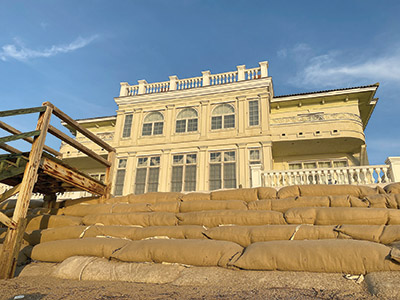Environment
Panel approves permanent sandbags as ‘research’

Four DeBordieu property owners who installed sandbags in front of their beachfront houses without state permits will be able to keep them as part of a research project they are funding through Coastal Carolina University. The board of the state Department of Health and Environmental Control last week overturned a staff decision to deny authorization for the research.
In addition to allowing the study, which may not start for a decade or more, the board said that any penalties imposed by the Office of Ocean and Coastal Resource Management for failing to obtain permits cannot include removal of the sandbags.
The study is an important step toward developing strategies that will preserve oceanfront properties from erosion, said state Sen. Stephen Goldfinch, one of three attorneys who argued for the property owners before the board.
“In my other career,” he told the DHEC board, “this is at the very top of everybody’s mind in my district. It’s extraordinarily important.”
The Coastal Conservation League is expected to appeal the board’s decision to the Administrative Law Court.
“It’s completely unnecessary and it’s illegal,” Leslie Lenhardt, an attorney with the S.C. Environmental Law Project who represents the conservation group, said after the hearing. “I think it’s highly likely that we’ll pursue it.”
The league also has an appeal pending before the state Court of Appeals over a permit that allows construction of groins as part of a renourishment project at DeBordieu, a project designed to protect the area where the sandbags are located.
Staff at Coastal Resources said leaving the sandbags in place would violate the state’s Beachfront Management Act and pose a threat to nesting sea turtles.
“The effect of sand bags is well known and has been studied for decades,” Blair Williams, manager of critical area permitting, told the DHEC board. “There is little to be gained in scientific knowledge that isn’t already known.”
The property owners were told in September 2019 that they would not receive a permit to bury large sandbags, Williams said. They placed the bags in the late summer of 2020 on four lots along a sea wall at the south end of DeBordieu.
The renourishment project is underway in that area that will pump up to 650,000 cubic yards of offshore sand onto the beach along with constructing three rock and concrete groins to hold the sand. Coastal Science and Engineering, which designed the project, said it would have a life of 10 to 12 years.
In addition to rendering the sandbags unnecessary for erosion protection, Williams said, the proposed research wouldn’t begin until the sandbags are exposed.
After Coastal Resources staff discovered the bags during a field inspection, the agency started an enforcement action. The property owners sought after-the-fact permits, something their attorneys said was not unusual.
In October, Paul Gayes, head of the Center for Marine and Wetland Studies at Coastal Carolina University, applied for approval for a research project that would require leaving the sandbags in place.
“We approached Dr. Gayes,” said Joe Owens, an attorney for the property owners.
He told the DHEC board that the sandbags are unlike those commonly used on the beach. They are manufactured by Heusker, a German firm with U.S. offices in North Carolina, from a heavier geotextile material that the company says won’t break down in the sunlight and is intended to accommodate plant and animal growth. They are also designed to be covered by sand, Owens said.
“They’re out of sight and out of mind,” he said. “It’s a proactive solution and the homeowners are all for it.”
Although DHEC regulations don’t allow the covering of sandbags or their use as a permanent installation, those regulations can be waived for research or pilot projects with a likelihood of success.
“This is an artificial beach. There’s nothing natural about it,” Owens said. “This is the perfect location to do this study.”
The seawall has been in place since 1981 and has often been exposed by erosion. When that happens, sea turtles can’t nest behind the wall, Owens said. The renourishment project will create a dune on top of the seawall and the buried sandbags.
He disputed claims that the sandbags would establish a precedent, saying not everyone can get someone with Gayes’s credentials as a coastal scientist to participate. Although Gayes told the board he has studied beaches since 1987, he said he wasn’t studying sandbags until approached by the DeBordieu property owners.
“It’s a private investment – these people are paying for it themselves – but it’s for a public benefit,” Owens said. “This is technology that can be used in this state.”
Board member Rick Lee of Rock Hill questioned why the sandbags were installed without a permit. Williams told the board that Coastal Resources staff didn’t object to them, only to the request to bury and leave them in place.
Goldfinch told the board that the owners didn’t know about the regulations.
“It’s unfortunate that a well-educated group of homeowners with considerable financial resources were unaware of the regulations that govern the property they own,” Lee said.
Goldfinch said they aren’t unique. He is representing two of the property owners, Rodney and Felicia Cain, in a lawsuit over sandbags that they discovered buried on their property in 2018, two years after they bought it. They allege that hundreds of sandbags were deliberately concealed by the former owners, Edward and Marcia Liddy, and not disclosed by the real estate company that handled the sale, Peace Sotheby’s International.
The suit, filed in November in Circuit Court, says the Cains “will be required to undertake extensive remediation of the property to preserve the same and/or mitigate impacts of erosion and to comply with laws and regulations affecting the property.”
The suit says the Liddys were on notice of the state beachfront regulations through a disclosure statement in their deed. The same statement was in the Cains’ deed.
Morgan Flake, a member of the Coastal Resources enforcement staff, told the DHEC board that “there were other violations” found during the investigation of the four sets of sandbags, but said she couldn’t say more because the action is still pending.
Goldfinch told the board that as a legislator he helped create the Technical Advisory Committee at Coastal Resources last year to help transition from a policy of retreat from the beach to preservation of beachfront property.
“Right now, all I’ve heard is ‘no’ from them,” he said. “We have to get smarter. We have to get faster.”
The advisory committee first met in October and is scheduled to deliver a report to the state Beach Preservation Committee in May.
Goldfinch said the first time he heard that Coastal Resources staff didn’t object to the DeBordieu sandbags themselves was at the hearing. If there is talk of fines, he asked the DHEC board to remember that.
After conferring in executive session with their attorney, the board voted 3-2 to overturn the staff decision. Lee made the motion adding that the enforcement action will continue but won’t be allowed to require removal of the sandbags.
Board members Sonny Kinney of Kiawah Island and Rob Morgan of Greenville also voted in favor.
Board members Jim Creel of Myrtle Beach and Morris Brown of Lake City were opposed.
“I support the concept of research and development, especially along the coast,” Creel said. “I’m just not comfortable that this is the right, appropriate place. And I just have concerns about that; to overturn the staff’s decision when I feel like they were clearly following the letter of the law.”
Seema Shrivastava-Patel of Lexington chaired the meeting, but didn’t vote.
“This decision was not taken lightly,” she said. “We have confidence in our staff.”




